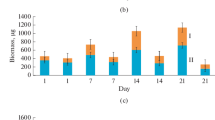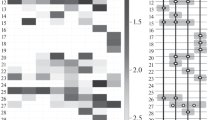Abstract
Molecular genetic techniques (FISH and metagenomic analysis) were used to investigate prokaryotic complexes in native soils (gray forest soil and urbostratozema typical), soils contaminated by petroleum products (gasoline or diesel fuel), and soils subject to remediation by addition of a nitrogen-containing polysaccharide biopolymer chitin. The share of metabolically active prokaryotic cells in the hydrolytic complex of soil microcosms was determined, as well as their biomass and biodiversity. Compared to the control, in the pollutant-containing experimental microcosms, a decrease in the share of metabolically active prokaryotic cells was observed, as well as changes of the hydrolytic complex structure, such as an increase in the share of the phylum Actinobacteria (specifically of the genera Galiella and Nocardioides in the samples contaminated with gasoline and diesel fuel, respectively). Supplementing the hydrocarbon-contaminated system the biopolymer chitin resulted in processing of mixed-minerals with an increase in the number of layers of the smectite type and, as a result, in formation of aggregates and improved aeration. An increase in the number of metabolically active prokaryotic cells and decreased diversity of the soil prokaryotic complex were observed, which were probably associated with the development of a selective group of the hydrolytic complex of chitindegrading microorganisms.
Similar content being viewed by others
References
Atlas, R.M, Microbial degradation of petroleum hydrocarbons: An environmental perspective, Microbiol. Rev., 1981, vol. 45, pp. 180–209.
Gritsenko, A.I., Ekologiya. Neft’ i gaz (Ecology. Oil and Gas), Moscow: Nauka, 1997.
Khomyakov, D.M. and Uzkikh, O.S, Diagnostics of petroleum-contaminated soils, Ekol. Normy. Pravila. Informatsiya, 2009, no. 3, pp. 34–39.
Koronelli, T.V., Dermicheva, S.G., and Semenenko, M.N., Rhodococcu as a natural sorbent of hydrocarbons, Mikrobiologiya, vol. 55, no. 4, pp. 683–686.
Manucharova, N.A., Gidroliticheskie prokariotnye kompleksy nazemnykh ekosistem (Hydrolytic Prokaryotic Complexes of Terrestrial Ecosystems), Moskow: Univ. Kniga, 2014.
Manucharova, N.A., Kol’tsova, E.M., Stepanov, A.L., Demkina, E.V., Demkin, V.A., and El’Registan, G.I, Comparative analysis of the functional activity and composition of hydrolytic microbial complexes from the Lower Volga barrow and modern chestnut soils, Microbiology (Moscow), 2014, vol. 83, no. 5, pp. 674–683.
Mikroorganizmy i okhrana pochv (Microorganisms and Soil Protection), Zvyagintsev, D.G., Ed., Moscow: Mos. Gos. Univ., 1989.
Nazina, T.N., Pavlova, N.K., Tatarkin, Yu.V., Shestakova, N.M., Babich, T.L., Sokolova, D.Sh., Ivoilov, V.S., Khisametdinov, M.R., Ibatullin, R.R., Tourova, T.P., Belyaev, S.S., and Ivanov, M.V, Microorganisms of the carbonate petroleum reservoir 302 of the Romashkinskoe oilfield and their biotechnological potential, Microbiology (Moscow), 2013, vol. 82, no. 2, pp. 190–200.
Nesterenko, O.A., Kvasnikov, E.I., and Nogina, T.M., Nokardiepodobnye i korinepodobnye bakterii (Nocardia-and Corynebacteria-Like Bacteria), Kiev: Naukova Dumka, 1985.
Pikovskii, Yu.I., Gennadiev, A.N., Chernyanskii, S.S, and Sakharov, G.N, The problem of diagnostics and standardization of the levels of soil pollution by oil and oil products, Euras. Soil Sci., 2003, no. 9, pp. 1010–1017.
PND F 16.1:2.2.22-98, Procedure for measurement of the mass fraction of petroleum products in mineral, organogenic, and organo-mineral soils and bottom sediments by IR-spectrometry, Moscow, 1998.
Polyanskaya, L.M, Geidebrekht. V.V., Stepanov, A.L., and Zvyagintsev, D.G., Distribution of microbial abundance and biomass along the profiles of zonal soil types, Pochvovedenie, 1995, no. 3, pp. 322–328.
Ryabchikov, A.M, Environmental contamination with oil, Vestn. MGU, 1974, no. 2, pp. 11–19.
Shlykov, V.G., Rentgenovskie issledovaniya gruntov (X-ray Investigation of Soils), Moscow: Mos. Gos. Univ., 1991.
Timergazina, I.F. and Perekhodova, L.S, Concerning the problem of biological oxidation of oil and petroleum products by hydrocarbon-oxidizing microorganisms, Neftegas. Geol. Theoriya i Praktika, 2012, vol. 7, no. 1, pp. 35–39.
Tolpeshta, I.I., Trofimov, S.Y., Erkenova, M.I., Sokolova, T.A., Stepanov, A.L., Lysak, L.V., and Lobanenkov, A.M, Laboratory simulation of the successive aerobic and anaerobic degradation of oil products in oil-contaminated high-moor peat, Euras. Soil Sci., 2015, vol. 48, pp. 314–324.
Author information
Authors and Affiliations
Corresponding author
Additional information
Original Russian Text © N.A. Manucharova, Yu.V. Kuteinikova, P.V. Ivanov, S.K. Nikolaeva, V.T. Trofimov, P.Yu. Stepanov, E.V. Tyapkina, D.N. Lipatov, A.L. Stepanov, 2017, published in Mikrobiologiya, 2017, Vol. 86, No. 3, pp. 373–382.
Rights and permissions
About this article
Cite this article
Manucharova, N.A., Kuteinikova, Y.V., Ivanov, P.V. et al. Molecular analysis of the hydrolytic component of petroleum-contaminated soils and of soils remediated with chitin. Microbiology 86, 395–402 (2017). https://doi.org/10.1134/S0026261717030092
Received:
Published:
Issue Date:
DOI: https://doi.org/10.1134/S0026261717030092




